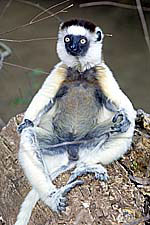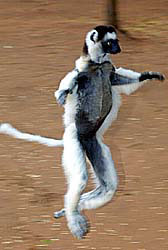|
|
|
|||||||
The planet's eighth continent remained largely undisturbed for the majority of its existence and has only felt the influence of man in the last two thousand years. In this short time, hungry humans have deforested 85% of the landmass, felled huge boabab, tamarind and ebony stands, remodelled vast tracts for agriculture and placed most of the endemic flora and fauna on the endangered and threatened lists.
Yet even as a developing country with some of the poorest people in the world, Madagascar retains a unique beauty and charm that attracts tourists, adventurers and scientists from all over the globe. But as an evolving nation still struggling to distance itself from a hectic colonial past, the population's priorities are not necessarily focussed on environmental conservation and preservation.
A healthy recovery in tourist traffic was rudely interrupted in mid-2002 by a bout of internal strife that saw bridges destroyed, roads blocked and the already delicate infrastructure further upset. That behind them, the now legitimised government can get on with resurrecting the economy and protecting the remaining, immensely valuable biodiversity.
 What
little the world knows about Madagascar is thanks to people like Sir
David Attenborough whose amazing BBC television series featured the
highly engaging and animated lemurs, chameleons and birds. John
Cleese's self-confessed love affair with the ring-tailed lemur also
helped put these delightful creatures on the screen and in the hearts
of the world.
What
little the world knows about Madagascar is thanks to people like Sir
David Attenborough whose amazing BBC television series featured the
highly engaging and animated lemurs, chameleons and birds. John
Cleese's self-confessed love affair with the ring-tailed lemur also
helped put these delightful creatures on the screen and in the hearts
of the world.
Consequently, ask any recent or prospective visitor to Madagascar what first comes to mind and they'll almost certainly answer; "the lemurs".
Despite their cute, cuddly teddy-bear looks, lemurs are actually primates, albeit an early incarnation that pre-dates the apes of neighbouring Africa. Madagascar has fifty surviving varieties (five families and fourteen genera) ranging from the 25g mouse-sized Pygmy Mouse Lemur to the very vocal Indri Indri which would, if it could, stand over a metre tall.
There are several locations dotted around the island where visitors can get a true up-close-and-personal experience with lemurs. Berenty in the south is famous for its Ring-Tailed Lemurs, Périnet in the east has both the Black and White Ruffed as well as the Brown Lemurs, while Lokobe and Nosy Komba on the northwest island of Nosy Be have semi-tame groups of Black Lemurs.
 Probably
the best known of these locations is Berenty
Reserve near the historic southern port and tourist town of Forth
Dauphin. Visited as much by bona-fide researchers as tourists, the lodge-style
accommodation is roomy, clean and comfortable even if some find it pricey
by Madagascan standards. The reserve itself was established in 1936
as something of a concession to the burgeoning sisal industry that is
responsible for over thirty thousand hectares of cleared land around
Berenty. The lodge's owner and local sisal baron, Jean de Heaulme, maintains
the reserve as much out of pragmatism as philanthropy and has even received
a WWF award for his efforts.
Probably
the best known of these locations is Berenty
Reserve near the historic southern port and tourist town of Forth
Dauphin. Visited as much by bona-fide researchers as tourists, the lodge-style
accommodation is roomy, clean and comfortable even if some find it pricey
by Madagascan standards. The reserve itself was established in 1936
as something of a concession to the burgeoning sisal industry that is
responsible for over thirty thousand hectares of cleared land around
Berenty. The lodge's owner and local sisal baron, Jean de Heaulme, maintains
the reserve as much out of pragmatism as philanthropy and has even received
a WWF award for his efforts.
Despite the ample wonders elsewhere, Berenty is likely to be the highlight of any visit to Madagascar. Troupes of semi-tame Ring-Tailed Lemurs patrol the grounds around the guest bungalows in search of morsels. These usually take the form of guest proffered bananas, but there is some contention about the impact of hand feeding, so this practice is being discouraged.
 Out
in the forest, visitors can either wander alone on the wide paths or
take a guided tour. Perched high in the tamarind trees, bands of White
Sifakas look imperiously down on the clumsy bipeds straining for a look
as they go about their business of selecting the juiciest leaves. A
parallel species of lemur, the Sifakas aren’t much interested
in humans, and who can blame them. Instead they leap and cavort amongst
the branches and occasionally come down for a stroll along the path.
“Stroll” is perhaps not the most accurate term; it’s
more a sort of alternating sideways skip that resembles some flamboyant
highland fling.
Out
in the forest, visitors can either wander alone on the wide paths or
take a guided tour. Perched high in the tamarind trees, bands of White
Sifakas look imperiously down on the clumsy bipeds straining for a look
as they go about their business of selecting the juiciest leaves. A
parallel species of lemur, the Sifakas aren’t much interested
in humans, and who can blame them. Instead they leap and cavort amongst
the branches and occasionally come down for a stroll along the path.
“Stroll” is perhaps not the most accurate term; it’s
more a sort of alternating sideways skip that resembles some flamboyant
highland fling.
Even when one considers
the myriad attractions of this vast island, Madagascar is certainly
not for everybody. It takes patience, perseverance and persistence to
get places, especially if you are making your own way overland. The
airline, Air Madagascar, is a competent enough operation although fraught
with delays and last minute rescheduling. The delightful Malagasy people
are cheerful and immensely tolerant of awkward westerners, even if service
standards are somewhat average by comparison. But the experiences delivered
by your efforts are more than enough to compensate for any perceived
hardships while your precious tourist dollars will go some way to preserving
that which you have just marvelled at.
|
Other Web Sites:
www.adventureassociates.com
- Adventure Travel Experts
SaveTheLemur.org
- Madagascar Fauna Group
www.primates.com
- Lemur info from this site
www.cia.gov
- CIA World Factbook info
www.bellanet.com
- Case study of deforestation in Madagascar
Background Image by Runic Design
|
|
|